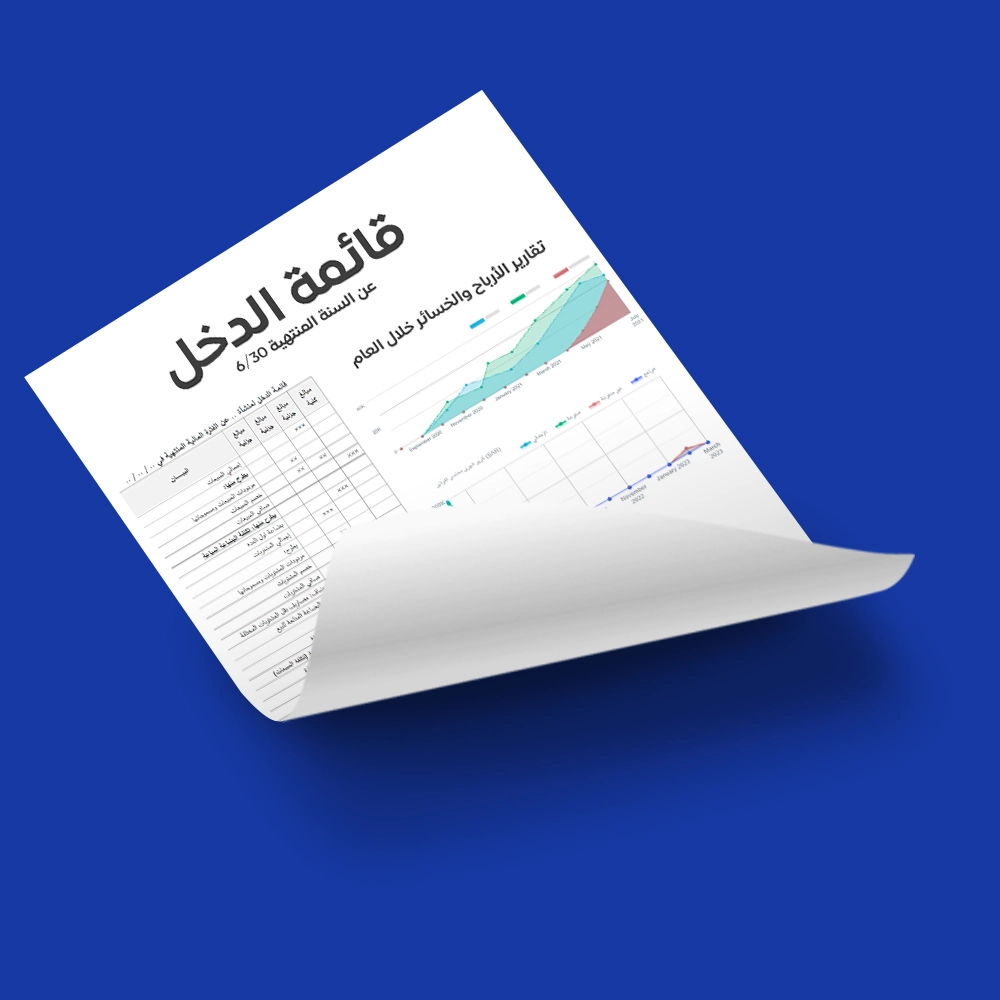Statement of Changes in Equity and Its Importance with Practical Examples

Table of contents:
- Summary of Key Points
- What is Stockholders' Equity in Accounting?
- What is the Statement of Changes in Stockholders' Equity in Accounting?
- What is the Purpose of Preparing the Statement of Stockholders' Equity
- What are the Components of the Statement of Stockholders' Equity
- What are the Items of Stockholders' Equity in Accounting?
- How to Create a Statement of Stockholders' Equity?
- How to Distribute Profits Through the Statement of Stockholders' Equity
- Examples of the Statement of Stockholders' Equity
- What is the Format of the Statement of Changes in Stockholders' Equity Items?
- Major Accounting Errors When Preparing the Statement of Stockholders' Equity and How to Avoid Them
- How to Manage the Statement of Stockholders' Equity in Daftra Software
- Frequently Asked Questions
The statement of stockholders' equity is one of the financial statements specific to business owners, serving as a mirror that reflects the company's true assets. How does the statement of stockholders' equity connect owners' capital with distributed and retained earnings? And how can strategic decisions be made through the statement of stockholders' equity? This article will clarify the importance of the statement of stockholders' equity, its components, and how to prepare it through practical steps.
Summary of Key Points
- The statement of stockholders' equity is one of the components of the balance sheet, prepared to identify changes that occurred in stockholders' equity, including share capital, assets, and earnings, during a specific time period.
- The importance of the statement of stockholders' equity lies in providing essential data for investors, lenders, and creditors to make sound financial decisions. It is considered one of the fundamental elements that links the balance sheet and income statement, providing a comprehensive overview of the entity's structure by identifying owners' rights, shares, and authorities, and helps ensure compliance with accounting standards for financial statement preparation.
- The statement of changes in stockholders' equity consists of several basic elements: share capital at the beginning of the period, additions or reductions to share capital, net income or net loss, cash reserves, retained earnings, dividend distributions, prior period adjustments, and ending balance.
- The statement of stockholders' equity is prepared through several key steps: gathering financial information, calculating the beginning balance, classifying equity items, tracking and recording changes in stockholders' equity, calculating the ending balance, and finally creating the stockholders' equity statement.
What is Stockholders' Equity in Accounting?
Stockholders' equity is the residual value of an entity's assets after deducting all liabilities. In other words, it represents what business owners or shareholders actually own of the company's net assets after fulfilling all debts. Also known as: shareholders' equity or net assets.
What is the Statement of Changes in Stockholders' Equity in Accounting?
The statement of stockholders' equity is the statement relied upon to prepare the balance sheet for the entity, as well as other financial statements such as the income statement and cash flow statement. Stockholders' equity is affected by net income or net loss during the year, as well as owners' capital contributions.
The statement of stockholders' equity is prepared to determine the changes that occurred in owners' equity during the financial period. Therefore, it shows each owner's equity at the end of the financial period after identifying assets and liabilities, since stockholders' equity equals the difference between the entity's assets and its liabilities.
What is the Purpose of Preparing the Statement of Stockholders' Equity
The uses of the statement of stockholders' equity for companies express its importance by showing the changes that occurred in the statement and determining profits or losses and other influential transactions. The objectives of preparing the statement of stockholders' equity are represented in the following points:
1- Providing Important Data About Capital
The statement of stockholders' equity provides important data for investors, lenders, creditors, and other stakeholders to understand how the entity's assets (capital) are managed, helping them evaluate the entity's performance and position, and make investment and financing decisions such as buying or selling shares, or requesting loans for expansion.
2- Foundation for Building the Balance Sheet
The balance sheet cannot be completed without the statement of changes in stockholders' equity, as stockholders' equity is an integral part of the balance sheet that consists of the entity's assets alongside its liabilities. Stockholders' equity appears on the equity side of the balance sheet.
It serves as an important link between the income statement and the balance sheet.
3- Clarifying Owners' Rights
The statement of stockholders' equity clarifies the percentages and shares of owners and shareholders in the entity through dividend distributions and participating shares, which helps provide a comprehensive overview of the entity's structure.
4- Determining the Entity's Financial Health
It is used to determine share capital at year-end to establish net stockholders' equity, as well as to understand the impact of profits or losses realized during the year on stockholders' equity, helping assess the entity's ability to generate sustainable profits.
5- Evaluating the Institution's Performance and Financial Position
The statement of stockholders' equity is used to determine share capital at year-end to establish net stockholders' equity, as well as to understand the impact of profits or losses realized during the year on stockholders' equity, helping evaluate the entity's financial position and performance through its ability to generate sustainable profits.
6- Compliance with Accounting Standards
The statement of stockholders' equity is an essential part of compliance requirements with accounting standards for financial statement preparation, which reflects the entity's financial health, credibility, transparency, and commitment to the principle of financial disclosure.
What are the Components of the Statement of Stockholders' Equity
Stockholders' equity in the balance sheet for sole proprietorships, partnerships, and corporations consists of several elements that cannot be overlooked when preparing the balance sheet. The following are the elements of the statement of stockholders' equity:
- Share capital at the beginning of the period.
- Additions or reductions to share capital during the financial period.
- Owner withdrawals.
- Net income or net loss.
- Cash reserves.
- Retained earnings.
- Dividend distributions.
- Prior period adjustments.
- Share capital at the end of the financial period (net stockholders' equity), which represents the ending balance.
Daftra accounting software helps you manage your accounts easily by preparing financial reports for you at the end of the accounting period.
What are the Items of Stockholders' Equity in Accounting?
Explaining the statement of stockholders' equity is important in clarifying the items and elements so they can be read correctly and accurately. The statement of stockholders' equity includes paid-in capital, retained earnings, reserves, and others. Learn about the stockholders' equity items in the following points:
1- Share Capital at the Beginning of the Period
Share capital at the beginning of the period represents the net share capital from the previous year and is recorded in the statement of stockholders' equity at the beginning of the new year to identify what changes occurred to it.
2- Additions and Reductions to Share Capital
Share capital additions during the financial period are any amounts added to increase share capital for the new year. For example, if the entity issued 100,000 shares at 3 riyals per share when the law states that the par value is 1 riyal per share, then 100,000 riyals is considered an increase to the original share capital, and 200,000 riyals is considered additional paid-in capital.
Share capital reductions represent any amounts taken from the entity's share capital that resulted in decreased share capital, such as owner withdrawals, which are any expenses taken from the entity for the benefit of the entity's owners, thus resulting in decreased share capital.
3- Net Income or Net Loss
This is the positive cash balance (profit) or negative (loss) that occurred during the year, calculated through the income statement. The calculation formula for net income is as follows:
Net Income = Gross Profit - Total Other Direct Costs (taxes, interest, operating expenses, rent, equipment, and employee salaries).
4- Cash Reserves
Financial laws require institutions to maintain a specific percentage for cash reserves, calculated from the year's net income and appearing in the statement of stockholders' equity twice: once as a positive value in the reserves column for the unused amount, and again as a negative under retained earnings because it wasn't used, thus reducing retained earnings.
Illustrative Example: If the year's net income equals 500,000 riyals and the reserve percentage equals 10%
Then reserves = 500,000 × 10% = 50,000 riyals.
Therefore, this amount is added to the reserves column once as positive and again as negative in the retained earnings column.
5- Retained Earnings
These are the entity's annual profits that will be carried forward to the next year, so they appear in the retained earnings column under net income, listed under the credit side in stockholders' equity. Retained earnings are reinvested in the company's business for expansion and growth purposes.
6- Prior Period Adjustments
These are adjustments made in previous years that were deducted from profits, but in the new year adjustments were made to add them to retained earnings in the new year. Therefore, the final total balance at the end of the period is the balance that appears in the balance sheet.
7- Ending Balance
Capital is calculated at the end of the financial period, or what is called net equity, which is the real amount that expresses the rights of owners after what has been added or decreased.
How to Create a Statement of Stockholders' Equity?
You can easily prepare a statement of stockholders' equity by gathering all necessary data, preparing a detailed table containing the statement of stockholders' equity items, and then verifying the accuracy of the entered data. Learn in detail about the steps for creating a statement of stockholders' equity in the following points:
1- Gathering Financial Information
Collecting basic financial information from accounting records to prepare the statement of changes in stockholders' equity, such as net income, profits, and losses. This information helps calculate beginning and ending balances and identify changes that occurred during the financial period.
2- Calculating the Opening Balance
Determining the opening balance for the time period on which the statement of stockholders' equity is prepared. The opening balance represents share capital at the end of the previous period.
The opening balance at the beginning of the period is calculated by adding share capital and retained earnings from the previous period and other comprehensive income, then subtracting these items from accumulated losses to obtain the beginning balance value in the statement of stockholders' equity.
3- Classifying Stockholders' Equity Items
Classifying stockholders' equity items as shown in the stockholders' equity statement template.
4- Tracking and Recording Changes in Stockholders' Equity
Tracking all changes to stockholders' equity that occurred during the specified time period, such as additions or reductions to share capital and their impact on net income and loss, then recording these changes in an organized and detailed manner in chronological order (by date), with a description for each element, and clarifying whether it's an addition or reduction to stockholders' equity through the use of either sign (+/-).
5- Calculating the Ending Balance
Calculating the ending balance, which represents net stockholders' equity. The ending balance is calculated by adding the beginning balance to net income and other revenues, then subtracting losses, dividend distributions, and personal withdrawals from share capital to obtain the closing balance of stockholders' equity in the balance sheet.
6- Creating the Stockholders' Equity Table
Preparing the stockholders' equity statement table and formatting it in an organized manner, clarifying the entity's name and the time period covered by the statement, then recording elements sequentially on the right side of the table and showing financial values on the left side of the table.
How to Distribute Profits Through the Statement of Stockholders' Equity
Profit distribution is carried out through the shareholders' or stockholders' equity statement through a series of steps, which include:
1- Earning Profits
When a company earns profits during a certain period, the board of directors can make a decision to distribute part of these profits to shareholders.
2- Determining the Amount
A specific percentage or amount of profits is determined for distribution, and this amount may vary based on the company's financial policy and future needs.
3- Accounting Record
After making the decision to distribute profits, dividend distributions are recorded in the accounting records. These distributions appear as a reduction in retained earnings, meaning that funds have been transferred from retained earnings to shareholders.
They represent the financial amounts distributed to owners from the year's profits; therefore, dividend distributions appear as negative amounts under retained earnings because they have been distributed.
Examples of the Statement of Stockholders' Equity
1- Sole Proprietorships
On 1/1/2020, the capital account balance for entity (A) was 8,000 riyals, and during the year, some accounting transactions occurred in the entity:
On 12/31/2020, the value of personal withdrawals by the business owner equaled 3,000 riyals.
Net income at year-end equaled 18,000 riyals.
Required: Prepare the statement of stockholders' equity at year-end and calculate net capital.
| Description | Amount |
| Share capital at the beginning of the period | 8,000 |
| (-) Personal withdrawals | (3,000) |
| (+) or (-) Net income or net loss | 18,000 |
| Share capital at end of financial period (Net stockholders' equity) | 23,000 |
Here, in the statement of stockholders' equity, share capital at the beginning of the period was determined, less personal withdrawals by owners, plus net income for the year, and the final result was net stockholders' equity or share capital at the end of the period.
2- Partnerships and Corporations:
On 1-1-2020, there was the following data:
Share capital = 1,000,000 riyals
Additional paid-in capital = 200,000 riyals
Cash reserves = 100,000 riyals
Retained earnings = 300,000 riyals
During the year, the following transactions occurred:
The entity issued 100,000 shares at 3 riyals each, and net income for the year was 500,000 riyals Annual reserve percentage was 10%, and dividend distributions for the year were 400,000 riyals Prior period adjustments equal 100,000
Required: Prepare the statement of stockholders' equity and determine the ending balance.
- First, all beginning balance data is recorded and totaled.
- Second, issuing 100,000 shares at 3 riyals each means the amount will be divided - part goes to original share capital and the other part to additional paid-in capital, i.e., 100,000 riyals to share capital and 200,000 riyals to additional paid-in capital.
- Third: The reserve percentage equals 10% and can be calculated from net income, i.e., 500,000 × 10% = 50,000 riyals. It appears once in the reserves column as positive, and again is deducted from retained earnings because it is being used.
- Fourth: Annual dividend distributions appear as negative because they have been distributed.
The statement is prepared as follows:
| Description | Share Capital | Additional Paid-in Capital | Reserves | Retained Earnings | Total |
| Beginning balance | 1,000,000 | 200,000 | 100,000 | 300,000 | 1,600,000 |
| Capital increase | 100,000 | 200,000 | - | - | 300,000 |
| Net income | - | - | - | 500,000 | 500,000 |
| Reserves | - | - | 50,000 | (50,000) | 0 |
| Dividend distributions | - | - | - | (400,000) | (400,000) |
| Prior period adjustments | - | - | - | 100,000 | 100,000 |
| Ending balance | 1,100,000 | 400,000 | 150,000 | 450,000 | 2,100,000 |
Therefore, the ending balance that appears in the balance sheet is 2,100,000.
What is the Format of the Statement of Changes in Stockholders' Equity Items?
The statement of changes in stockholders' equity consists of several items and elements, arranged in a specific order to enable decision-makers to read it easily. Learn about the format of the statement of changes in stockholders' equity items through the following points:
| Description | Share Capital | Additional Paid-in Capital | Reserves | Retained Earnings | Total |
| Beginning balance | XX | XX | XX | XX | XX |
| (+) or (-) Additions or reductions to share capital during the financial period | - | - | - | - | XX |
| (-) Personal withdrawals | - | - | - | - | (XX) |
| (+) or (-) Net income or net loss | - | - | - | - | XX |
| Cash reserves | - | - | - | - | XX |
| (-) Dividend distributions | - | - | - | - | XX |
| Prior period adjustments | - | - | - | - | XX |
| Ending balance (Net stockholders' equity) | - | - | - | - | XX |
Also Read: What is the cash flow statement, and how to prepare it Everything you want to know about the balance sheet Definition of comparative financial statements
Major Accounting Errors When Preparing the Statement of Stockholders' Equity and How to Avoid Them
There are some accounting errors that can occur when preparing the statement of stockholders' equity, and these errors must be handled with great precision and periodic review. The following are the most prominent accounting errors related to preparing the statement of stockholders' equity, along with the necessary solutions to control and avoid them, ensuring the preservation of financial information quality and increasing investor confidence:
1- Lack of Accuracy When Entering Numbers
Incorrect entry of numbers related to the statement of stockholders' equity leads to misleading financial information, thus affecting the accuracy of financial statements such as the balance sheet and income statement. Therefore, periodic auditing of entered data should be conducted, and comprehensive accounting software should be used for business management, leading to reliable results and reducing human errors.
2- Incorrect Calculation of Retained Earnings
Calculating retained earnings inaccurately or omitting them consequently affects total stockholders' equity. Therefore, retained earnings should be updated periodically after dividend distributions and based on profits and losses for each accounting period.
3- Omitting Some Items of the Statement of Stockholders' Equity
Sometimes, some stockholders' equity elements are omitted, such as designated reserves or issued shares, and some important transactions, such as share transfers or changes in ownership. Therefore, all previously mentioned stockholders' equity elements should be included, and periodic reviews should be conducted to ensure all stockholders' equity-related transactions are recorded.
How to Manage the Statement of Stockholders' Equity in Daftra Software
Daftra accounting software provides you with a diverse range of account reports, such as personal withdrawals, buying or selling shares, revenues, profits, losses, and expenses, as well as clarifying sources and dates of transactions that led to capital increases from partners or external financiers.
These accounts are the foundation for preparing the shareholders' or stockholders' equity statement. The system's dashboard allows issuing these reports with flexibility, in an accurate and simple presentation method, where you can issue them in summary or detailed form for each report item separately.
Finally, you can keep the report digitally on your device or print it in paper form.
Frequently Asked Questions
What is the difference between share capital and stockholders' equity?
Share capital is the amount contributed by owners and shareholders for investment in the company, while stockholders' equity includes share capital, retained earnings, accumulated reserves, and other comprehensive income elements.
What is non-controlling interest?
It represents the rights of shareholders who do not own a controlling interest in the company, also called minority interests. It is determined in the net assets of subsidiary companies and is presented in the balance sheet separately from liabilities and stockholders' equity.
What is Average Equity?
Average equity reflects the time-weighted average of investments made by shareholders and owners in the company during a specific period, for analyzing financial performance and measuring the efficiency of using stockholders' equity in investment and achieving profitable returns.
Average equity is calculated by adding stockholders' equity values at the beginning and end of the period, then dividing the sum by the number of periods used.
For example, if stockholders' equity at the beginning of the period = 50,000 Saudi riyals and at the end of the period equals 75,000 Saudi riyals, and the number of comparison periods is 2, then average equity will be calculated as follows:
Average Equity = (Beginning Equity + Ending Equity) / 2 = (50,000 + 75,000) / 2 = 62,500 riyals.
What does an increase in shareholders' equity mean?
An increase in shareholders' equity indicates an increase in the value of owners' and partners' investment in the institution, which indicates its growth, strength, and financial stability, and proves the institution's credibility and good reputation that attracts more shareholders and investors.
Are withdrawals part of stockholders' equity?
Yes, personal withdrawals are considered basic components of stockholders' equity as they represent financial or non-financial values deducted from share capital or asset values. Therefore, they are a fundamental form showing changes in stockholders' equity, which naturally affects the rate of distributed and retained earnings.
What are the types of stockholders' equity in accounting?
Types of stockholders' equity in accounting are:
- Common Stock: Shares that allow voting rights and profit participation.
- Preferred Stock: Shares that give the holder special rights, such as preferred dividend distributions.
- Retained Earnings: Profits that are reinvested.
- Reserves: Cash amounts allocated as reserves for specific purposes such as meeting obligations.
What is the relationship between the balance sheet and statement of stockholders' equity?
The relationship between the statement of stockholders' equity and the balance sheet is complementary, as stockholders' equity is part of the structural composition of the balance sheet. The balance sheet also shows the relationship between assets, liabilities, and stockholders' equity through the equation (Assets = Liabilities + Stockholders' Equity). This equation shows the sources the company relies on for financing, either through debt (represented by liabilities) or shareholder investments (represented by stockholders' equity).
What is the difference between the statement of stockholders' equity and the balance sheet?
Although the statement of stockholders' equity is part of the balance sheet, the difference between them appears in the time frame each covers. The statement of stockholders' equity is prepared periodically in each financial period to show changes in stockholders' equity during that period, while the balance sheet is usually prepared at the end of the accounting period to provide a comprehensive view of the company's financial position and help investors and financiers make necessary decisions based on evaluating the company's ability to meet its obligations and achieve profit.
What is the difference between stockholders' equity components in sole proprietorships, partnerships, and corporations?
The difference between shareholders' or stockholders' equity components in sole proprietorships, partnerships, and corporations can be clarified through the following comparison:
| Stockholders' Equity Components | Sole Proprietorship | Partnerships | Corporations |
| Invested Capital | Owner's Capital | Paid-in Capital (shares and stakes) | Share Capital |
| Net Income or Net Loss | Reserves | Changes in shareholders' equity during the accounting period | Net Income/Loss |
| Owner's Current Account (deposits and personal withdrawals) | Partners' Current Account | - | Retained Earnings |
What factors affect the statement of stockholders' equity?
The statement of stockholders' equity is affected by several factors that can be summarized as: retained earnings from stockholders' equity percentage, losses deducted from retained earnings that negatively affect reducing owners' rights, dividend distribution percentages to shareholders, new investments leading to increased share capital, share purchases leading to reduced paid-in capital value, changes in market value of assets affecting stockholders' equity, and finally obligations affect stockholders' equity - the more obligations increase without balancing with covering assets, the more the institution's financial health is affected and its inability to meet obligations and profits due to shareholders.
Conclusion After learning about the definition and format of the statement of stockholders' equity, it can be said that understanding the statement of stockholders' equity enables companies to evaluate their financial performance, then helps them enhance owners' confidence and support shareholders' credibility, as well as direct financial management strategies toward growth, expansion, and achieving more profits.















